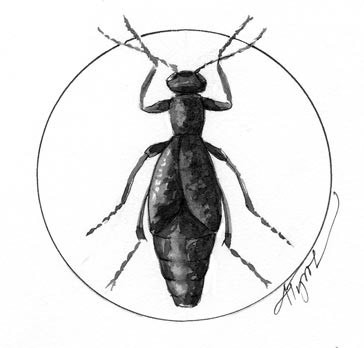
Years ago, I learned that the large, bulbous, metallic-blue beetles that are often found on the lawn are called blister beetles. When bothered, they exude a clear, orange liquid from their joints that is particularly noticeable on their legs, where it oozes from every segment. The orange secretion stays in bright, round droplets, and if you get it on your skin, I’d been told, blisters will develop in a day.
I gently poked the next blister beetle that I found and put some of the oily orange liquid on the tender skin on the underside of my arm. No blisters developed the next day or the next. Clearly, I thought, this must be yet another example of anti-insect alarmist propaganda.
These beetles are quite common and easy to catch, so it wasn’t long before I was able to confidently put some orange beetle exudation on the skin of a friend, eager to share my reassuring discovery about the harmlessness of the misnamed beetle. Instead of reassurance, however, a large, fluid-filled blister developed on his arm. He was kind enough not to mention that it took several weeks to heal.
Insects from several orders bleed in response to attack. Reflex bleeding, as it is called, enables them to emit distasteful or poisonous chemicals when and where they are needed. The blood of members of the Meloidae, the blister beetle family, contains high concentrations of cantharidin, also known as Spanish fly. This powerful toxin immediately deters many potential predators and is especially effective against ants. If you find one of these beetles – the bulbous blue one that you are most likely to notice is in the genus Meloe – and slightly pinch one of its legs, sort of like what an ant would do, only that leg will bleed. Insect blood is precious, even though it does not transport oxygen the way our blood does, and it behooves a blister beetle to be efficient in deploying its defense system. A whole-body squeeze will produce orange droplets from many joints.
The toxicity of cantharidin is impressive. As little as 100 milligrams is reported to be fatal to humans if ingested, and this amount can be extracted from just a few beetles. For centuries, cantharidin was misused as an aphrodisiac and in many folk-medicine cures, but now it’s mostly horses that are threatened by it. The compound retains its toxicity after the beetle dies, and when beetles foraging in the alfalfa are inadvertently baled up and their dried remains are later fed to horses, as little as five grams of dried beetle can be lethal.
Both male and female blister beetle larvae produce cantharidin, and they regurgitate it when they are molested. When the females mature, they lose the ability to synthesize it and by then have typically exhausted their larval supply. Mature males, on the other hand, are able to produce large quantities of cantharidin, which they offer to females for ingestion during courtship and mating. The mate of a well-endowed male then is able to transfer the compound to her eggs, thus protecting her offspring from ants and other predators.
The usefulness of this poison is not lost on a number of other insects that are not bothered by it. Karl Gornitz, a German entomologist, put out insect traps baited with cantharidin in the 1930s, and they attracted flies, midges, bees, wasps, and many other kinds of beetles from a long distance, even when the bait was present in minute quantities. This phenomenon, now known as cantharidiphilia, has, in turn, attracted many researchers.
The courtship of a much-studied, fire-colored beetle called Neopyrochroa flabellata centers around cantharidin, even though these beetles are unable to synthesize the compound themselves. The male of the species has a special pocket in his head, and if he is able to fill it with cantharidin that he has previously ingested, it gives him an advantage in courtship. The female grasps the male and proceeds to inspect his head with her mandibles for the presence of cantharidin, which she then eats. She knows that a good supply in his head is like a promissory note saying that more will be transferred to her during mating. Poorly endowed suitors are rejected.
The many other cantharidiphiles use the potion to entice females in much the same way. It is assumed that meloid beetles like the ones in my lawn are the source of most of the cantharidin that makes its way into the insect sex trade, but how the other insects obtain it is a mystery.
I tried giving myself a blister beetle blister a few weeks ago and, again, no luck. Now that I know a bit more about cantharidin, I think I will relinquish my interest to the needs of the true cantharidiphiles.

